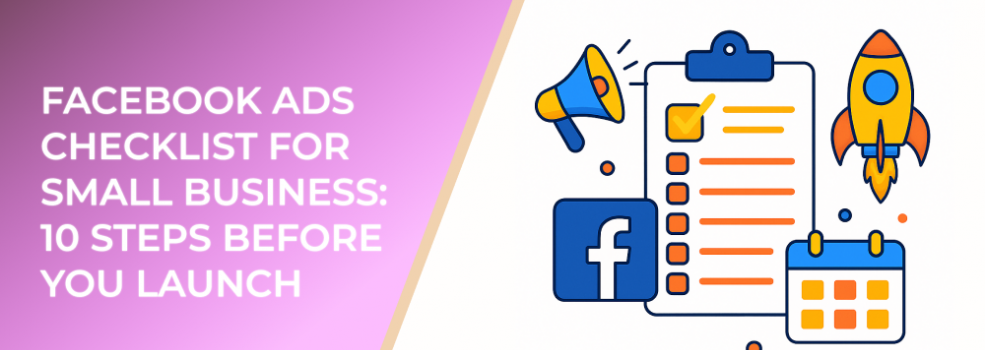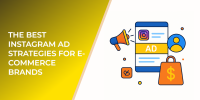For small businesses, every dollar spent on ads has to prove its value. Yet studies show that more than 40% of small businesses run Facebook ads without proper tracking or goal‑setting, often leading to poor ROI. This checklist gives you a structured process that prevents common mistakes and positions your campaign for profitable scaling.
10 Steps Before You Launch
1. Define your campaign objective
Pick a single objective (Sales, Leads, or Engagement) that matches your business goal. Campaigns with one clear objective see up to 30% better optimization outcomes than those with mixed goals.
2. Install and verify the Meta Pixel
Tracking is non‑negotiable. The Meta Pixel gives you real data about leads, sales, and events. Businesses with correct Pixel setup report 10–20% better return on ad spend (ROAS) due to smarter optimization.
3. Prepare a clean conversion funnel
Make sure your landing page loads in under 3 seconds and has one primary call to action. Every additional second of delay can reduce conversions by 7% or more.
4. Know your customer profile
Define age, location, interests, and buying triggers. Facebook’s algorithm works best when you provide a sharp starting point, and small businesses that clearly outline buyer personas often see lower CPAs by 15–25%.
5. Build your audiences
Set up:
-
A cold audience (interests, demographics).
-
A warm audience (website visitors, engaged social users).
-
A lookalike audience (if you already have customer data).
Retargeting warm audiences typically drives 20–50% cheaper conversions compared to cold audiences.
6. Map out your ad structure
Start lean:
-
One campaign.
-
2–3 ad sets.
-
2–3 ads per set.
Simpler accounts leave the Learning Phase 1–3 days faster and stabilize CPAs more quickly.
7. Plan your budget
Allocate 3–5× your target cost per conversion as a daily budget across ad sets. Example: If you want $20 leads, plan for at least $60/day total. Scaling too soon can spike costs.
8. Develop three creative variations
Test three different angles:
-
Problem/solution.
-
Testimonial or social proof.
-
Product demo or lifestyle use case.
Ads using authentic customer voices (UGC style) often reduce acquisition costs by 15–35% compared to polished, brand‑first ads.
9. Write ad copy with a strong hook
Hook in the first line, clear benefit in the middle, and one CTA at the end. Short, benefit‑driven copy often achieves 20% higher click‑through rates than feature‑heavy copy.
10. Set up reporting and KPIs
Decide your main success metric (CPA, ROAS, or CPL) and track daily. Advertisers who monitor cost per result every 24 hours are more likely to adjust in time and protect budget.
The small business launch timeline
-
Day 0: Pixel installed, funnel tested, checklist complete.
-
Day 1–3: Launch campaigns. Expect volatility in CPMs and CPAs. Avoid changes.
-
Day 4–7: Shift budget toward early winners. Replace weak creatives.
-
Day 8–14: Scale budgets gradually (+15–20% at a time) if metrics are stable.
Useful Statistics Recap
-
40%+ of small businesses run ads without tracking → wasted spend.
-
Pixel setup improves ROAS by 10–20%.
-
Each second of landing page delay cuts conversions by 7%.
-
Warm audiences deliver 20–50% cheaper conversions.
-
Simplified structures stabilize costs 1–3 days faster.
-
UGC ads reduce acquisition costs by 15–35%.
Where to go next on LeadEnforce
After you’ve checked off these 10 steps, take your setup deeper with:
-
Facebook Ads Not Converting: How To Fix It — practical fixes for struggling campaigns.
-
Meta Ad Campaign Objectives Explained: How to Choose the Right One — avoid the costly mistake of wrong objectives.
-
How to Define a Target Audience for Marketing: a Step‑by‑Step Guide — sharpen your targeting and improve efficiency.
Final word
A disciplined pre‑launch checklist is the difference between testing smart and wasting budget. Follow these 10 steps, start small, and keep your structure simple. With proper tracking, audiences, and creatives, your first Facebook ad campaign can deliver data you can trust and a foundation for growth.

